
National Park: Rivers at Risk Report Launched
Our new research shows National Park rivers are being failed by government and water regulators and are now under threat.
Published: 8 October 2023

A glorious summer’s day in the South Downs National Park on the banks of the river Meon. This beautiful little chalk stream, internationally rare and one of only around 200 or so in the world, holds my heart. Childhood days splashing in its crystal-clear waters, looking for minnows and bullheads set me on my own journey into conservation. But today, we are fishing on a bigger scale. I am excited to join the Environment Agency’s expert ecologists as they conduct a fish survey of the river. These surveys are incredibly important to assess the health of the ecosystem and understand the impact that climate change and pollution is having on wildlife. But ecological monitoring of rivers like the Meon has become less frequent due to cuts to the Agency’s budget.
From the bank, I have spotted a couple of brown trout, but team leader Matt reassures that fish are expert at camouflage and this is prime habitat. This reach of river is part of St Clair’s nature reserve, created when the Hampshire and Isle of Wight Wildlife Trust bought the land a few years ago; already we can see the positive impact that conservation grazing is having. Unlike some stretches of (heavily fished) chalk stream, the river here has wild banks, festooned with grasses and colourful aromatic herbs. Water rushes round meanders. An old willow tree reaches up and over the river, setting down roots on the far bank, making a natural arch. Rare for rivers these days, it is actually connected to the flood plain of ancient water meadows, with a series of pools and ditches creating a mosaic of wet and dry habitat, buzzing with insects – my favourite are the sapphire-blue banded demoiselles. The herd of native cattle look on with mild curiosity as they watch the team unload the gear. This is a tiny corner of the National Park, but it shows it at its best, giving a glimpse of what wilder National Parks could be, with the right Government support and powers.
Into the water the ecologists go, with electro fishing gear and a small boat with oxygenated tanks to keep fish they catch safe until they can be counted. First, a temperature check – it’s 14 degrees – cold compared to the balmy air, as the chalk water is coming up from a deep underground aquifer. Matt explains that when the water is too hot, they can’t survey, because over 18 degrees the fish become stressed. Climate change – typified by last year’s long hot summer was deeply worrying as the rivers heated and flows dropped, pollutants became more concentrated. Downstream, the estuary heated up to an astonishing 25 degrees, disastrous for migratory fish that use the rivers to spawn and resulting in critically low salmon numbers (mirrored on rivers across the South, including the neighbouring Itchen and the Exe in Exmoor). This summer’s rain and cooler temperatures – and shady banks like these – are a blessing for fish in a changing climate.
The team starts to survey: it’s brilliant to watch, swooping and lurching to catch fish temporarily stunned by the electric current. Hooking out so many creatures that were hiding in the shallow waters and swathes of water weed. Back on the bank, one by one, the fish are counted and measured and inspected for signs of disease and then released. Wild brown trout, minnows, stickleback and bullhead – and eels – so many! The team count 261 fish in total, from different age classes – a good sign – from only a 100m stretch of this little chalk stream. Some whopper eels (the biggest they’ve seen), over 60cm – at that size, Matt estimates it to be 25 years old. It still has a yellow hue – soon it will turn silver and swim downstream and out hundreds of miles to the Sargasso Sea (in the middle of the Atlantic) to spawn, before its baby elvers will return to this corner of the South Downs.

I am amazed – it was the most joyous things, to see all this wildlife, long hidden from view. Awe and wonder are the perfect tonic for eco anxiety: one of the most important things our National Parks provide. Matt is disappointed by the numbers (in a good year, they might have got double from this stretch) but also expected it, given the severe drought conditions last year that really stressed this ecosystem. We talk about resilience to climate change, the importance of habitat restoration as adaptation: shade, meanders that allow deep pools and faster riffles, wild banks – this is a great example. We talk about the need to reduce fine silt in the river: the Meon is an agricultural catchment and can be flashy for a chalk stream given the slope of the Downs. So much of river health is dependent on what happens beyond its banks, in the ‘terrestrial’ landscape, the farmers’ fields and across the catchment. This is where the National Park role is so important: the South Down National Park Authority have supported farmer clusters who are planning a landscape scale nature recovery project on the Meon, but with support could do so much more. It’s why it’s so important that Farming in Protected Landscapes and Landscape Recovery schemes are significantly scaled up, funded and extended into ELM (Defra’s new agri-environment scheme).
We also talk about sewage: this idyllic chalk stream in a National Park is not immune. Sewage is a real issue, with water company works and countless unregulated septic tanks from homes and businesses all polluting the gin-clear stream, blighting the river like a thousand small cuts. Even though it is an internationally rare chalk stream in a National Park, the Meon has no special protection. And that means that it is pretty much ignored when it comes to water company investment. Unlike the neighbouring Itchen, this stream is not a SSSI and thus Southern Water is not required to put in additional treatment, like Phosphate stripping, on sewage works. South East Water and Portsmouth Water can continue taking drinking water from the catchment, dwindling the flows.
It’s time the rivers in National Parks were actually protected. The purpose of a National Park is to conserve and enhance wildlife. Yet it is failing its freshwater ecosystems across the country, from here on the Meon, to Windermere in the Lake District. That’s why we are calling on Government to require public bodies, including water companies, to further those National Park purposes. This would make a real difference, requiring water companies to invest to protect these rivers and stop exploitation. The Government still has a chance this September to put that change into law. Let’s hope for the sake of the salmon, the sea trout, the minnows and eels, that it gets its act together.

Our new research shows National Park rivers are being failed by government and water regulators and are now under threat.

The Cunliffe Independent Water Commission has published recommendations for reforming the water regulatory system, but throughout this detailed report National Parks fail to be mentioned.

The UK Government has released official data on the state of nature in England’s Protected Landscapes, marking a big step forward in understanding how these special places are faring.